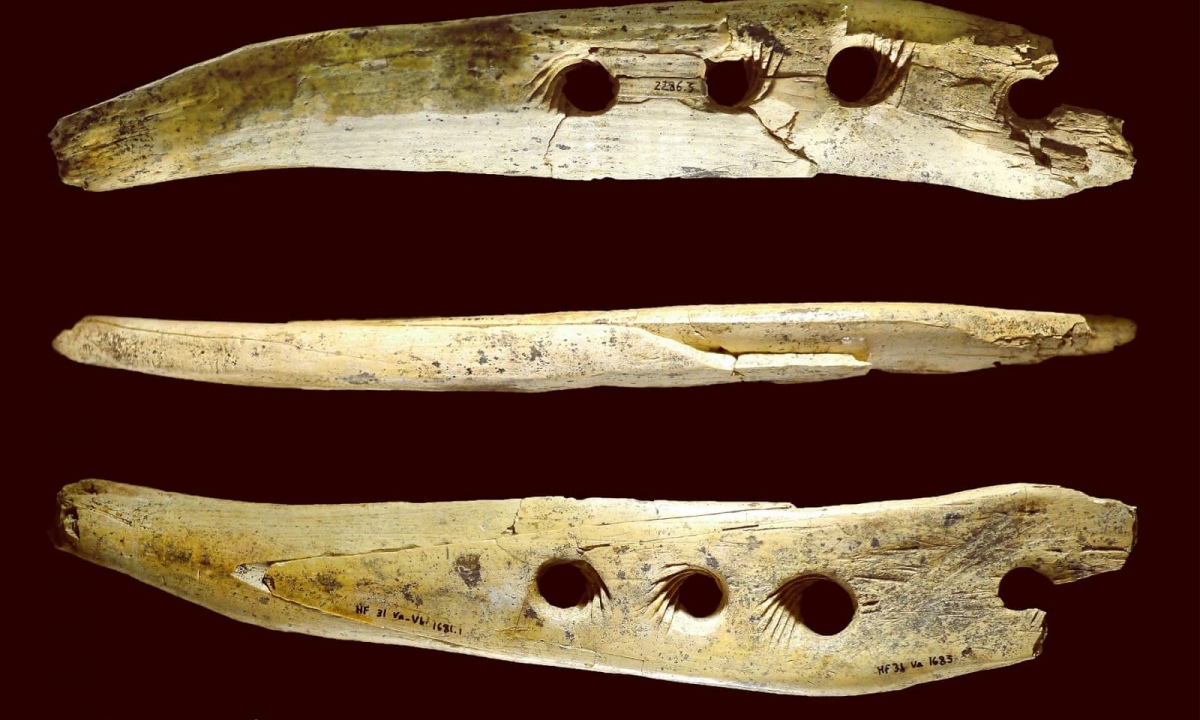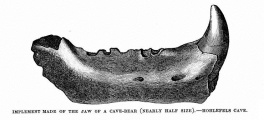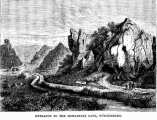<< Our Photo Pages >> Hohlefels Höhle - Cave or Rock Shelter in Germany in Baden-Wuerttemberg
Submitted by AlexHunger on Sunday, 02 August 2020 Page Views: 12102
Mesolithic, Palaeolithic and EarlierSite Name: Hohlefels Höhle Alternative Name: Hohle Fels Cave, Hohler Fels, Venus of SchelklingenCountry: Germany Land: Baden-Wuerttemberg Type: Cave or Rock Shelter
Nearest Town: Ulm Nearest Village: Schelklingen
Latitude: 48.379167N Longitude: 9.755556E
Condition:
| 5 | Perfect |
| 4 | Almost Perfect |
| 3 | Reasonable but with some damage |
| 2 | Ruined but still recognisable as an ancient site |
| 1 | Pretty much destroyed, possibly visible as crop marks |
| 0 | No data. |
| -1 | Completely destroyed |
| 5 | Superb |
| 4 | Good |
| 3 | Ordinary |
| 2 | Not Good |
| 1 | Awful |
| 0 | No data. |
| 5 | Can be driven to, probably with disabled access |
| 4 | Short walk on a footpath |
| 3 | Requiring a bit more of a walk |
| 2 | A long walk |
| 1 | In the middle of nowhere, a nightmare to find |
| 0 | No data. |
| 5 | co-ordinates taken by GPS or official recorded co-ordinates |
| 4 | co-ordinates scaled from a detailed map |
| 3 | co-ordinates scaled from a bad map |
| 2 | co-ordinates of the nearest village |
| 1 | co-ordinates of the nearest town |
| 0 | no data |
Internal Links:
External Links:
I have visited· I would like to visit
Andy B has visited here

The first excavation took place in 1870, yielding remnants of cave bears, reindeer, mammoths and horses as well as tools belonging to the Aurignacian culture of the Upper Paleolithic. The cave was inhabited from 30,000 BC.
Further excavations in 1958 to 1960, 1977, and 2002 yielded a number of spectacular finds, including several specimens of prehistoric sculpture such as an ivory bird and a human-lion hybrid figure similar to the lion man of the Hohlenstein Stadel but only 2.5 cm tall.
In 2008, a team from the University of Tübingen, led by archaeologist Nicholas Conard, discovered an artifact known as the Venus of Hohle Fels, dated to around 35,000 to 40,000 years ago. This is the earliest known Venus figurine and the earliest undisputed example of figurative art. The team also unearthed a bone flute in the cave, and found two fragments of ivory flutes in nearby caves. The flutes date back at least 35,000 years and are the earliest musical instruments ever found.
Artifacts are at Tübingen Universität museum
Source: Wikipedia
The Venus of Hohle Fels has been dated to between 35,000 and 40,000 years ago, belonging to the early Aurignacian, at the very beginning of the Upper Paleolithic, which is associated with the assumed earliest presence of Homo sapiens in Europe (Cro-Magnon). It is the oldest undisputed example of Upper Paleolithic art and figurative prehistoric art in general. In 2011, the figure is still being researched in the University of Tübingen, though there are plans to house it and other discoveries from the region in a planned new museum in Swabia.
More at: Wikipedia and see the comments below for the latest discoveries.
Note: Archaeologists discover the oldest tool used to manufacture twine (probably), see the comments on our page for this and many more discoveries from Hohle Fels Cave
You may be viewing yesterday's version of this page. To see the most up to date information please register for a free account.









Do not use the above information on other web sites or publications without permission of the contributor.
Click here to see more info for this site
Nearby sites
Click here to view sites on an interactive map of the areaKey: Red: member's photo, Blue: 3rd party photo, Yellow: other image, Green: no photo - please go there and take one, Grey: site destroyed
Download sites to:
KML (Google Earth)
GPX (GPS waypoints)
CSV (Garmin/Navman)
CSV (Excel)
To unlock full downloads you need to sign up as a Contributory Member. Otherwise downloads are limited to 50 sites.
Turn off the page maps and other distractions
Nearby sites listing. In the following links * = Image available
966m N 8° Sirgenstein Höhle Cave or Rock Shelter
2.5km NNE 30° Geissenklösterle Höhle* Cave or Rock Shelter
3.4km NNE 29° Brillenhöhle* Cave or Rock Shelter
4.1km NE 47° Grosse Grotte Cave or Rock Shelter
7.0km NE 55° Schanzhau Wald Grabhügelgruppe Artificial Mound
7.1km ENE 58° Schanzhau Wald Keltische Viereckschanze Ancient Village or Settlement
8.0km NW 319° Sontheimer Höhle Cave or Rock Shelter
9.0km ESE 120° Erbach Viereckschanze Ancient Village or Settlement
9.1km ESE 120° Erbach Grabhügelgruppe Barrow Cemetery
12.8km ENE 74° Ehrenstein Ancient Village or Settlement
17.6km NNW 335° Westerheim Keltische Viereckschanze Ancient Village or Settlement
18.6km NW 312° Zainingen Grabhügelfeld Barrow Cemetery
19.0km SW 226° Bärenhöhle Cave or Rock Shelter
21.6km WSW 243° Alt-Hayingen Hillfort
23.0km SW 220° Langhau Wald Grabhügelgruppe Barrow Cemetery
23.1km SSW 198° Grundsheim Grabhügelgruppe Barrow Cemetery
23.1km SW 219° Langhau Wald Keltische Viereckschanze Ancient Village or Settlement
26.8km NE 55° Fohlenhaus-Höhlen Cave or Rock Shelter
26.9km NW 307° Grabenstetten Museum Museum
28.3km SSW 212° Bussen Vorgeschichtliche Höhensiedlung Hillfort
28.6km W 272° Sternberg Grabhügelgruppe Barrow Cemetery
29.1km NW 306° Heidengraben Keltisches Oppidum Ancient Village or Settlement
29.9km ENE 64° Museum für Vor-und Frühgeschichte des Lonetales Museum
30.1km SSW 196° Ödenahlen Ancient Village or Settlement
30.5km NW 305° Gräberfeld am Burrenhof* Barrow Cemetery
View more nearby sites and additional images






 We would like to know more about this location. Please feel free to add a brief description and any relevant information in your own language.
We would like to know more about this location. Please feel free to add a brief description and any relevant information in your own language. Wir möchten mehr über diese Stätte erfahren. Bitte zögern Sie nicht, eine kurze Beschreibung und relevante Informationen in Deutsch hinzuzufügen.
Wir möchten mehr über diese Stätte erfahren. Bitte zögern Sie nicht, eine kurze Beschreibung und relevante Informationen in Deutsch hinzuzufügen. Nous aimerions en savoir encore un peu sur les lieux. S'il vous plaît n'hesitez pas à ajouter une courte description et tous les renseignements pertinents dans votre propre langue.
Nous aimerions en savoir encore un peu sur les lieux. S'il vous plaît n'hesitez pas à ajouter une courte description et tous les renseignements pertinents dans votre propre langue. Quisieramos informarnos un poco más de las lugares. No dude en añadir una breve descripción y otros datos relevantes en su propio idioma.
Quisieramos informarnos un poco más de las lugares. No dude en añadir una breve descripción y otros datos relevantes en su propio idioma.